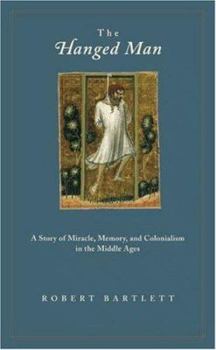The Hanged Man: A Story of Miracle, Memory, and Colonialism in the Middle Ages
Select Format
Select Condition 
Book Overview
Seven hundred years ago, executioners led a Welsh rebel named William Cragh to a wintry hill to be hanged. They placed a noose around his neck, dropped him from the gallows, and later pronounced him... This description may be from another edition of this product.
Format:Hardcover
Language:English
ISBN:0691117195
ISBN13:9780691117195
Release Date:February 2004
Publisher:Princeton University Press
Length:192 Pages
Weight:0.90 lbs.
Dimensions:0.8" x 5.5" x 8.5"
Customer Reviews
2 ratings
Thereby Hangs a Tale
Published by Thriftbooks.com User , 14 years ago
In 1307 a papal tribunal met in England, pursuant to Pope Clement V's order of 1306. It was investigating a supposed miracle of Thomas de Cantaloupe, deceased (1282) Bishop of Hereford and candidate for canonization. The miracle was the resurrection of a dead Welshman, William Cragh, an alleged outlaw and traitor, whom the English Marcher baron William de Briouze had captured and hung in 1290. Cragh's gallows broke, so he was hanged again. The rope broke, but by then (according to the witnesses) Cragh was very dead. But he was "returned to life," supposedly by the intercession of De Canteloupe, to whom he had prayed. The tribunal consisted of three senior clergymen from England (one) and France (two) supported by notaries who provided verbatim transcripts of the proceedings (including witness testimony, some from non-English/French speakers). The tribunal heard testimony from 44 witnesses in all and reviewed documents. These records survive. From this author Bartlett has built a short (only 142 text pages) but brilliant book that allows us a window on medieval life based on the words and thoughts of men and women who lived it. Three examples illustrate the method. For Bartlett the tribunal highlights the overwhelming superiority of the Church's literacy, organization, learning and culture in a society where many even of the aristocracy were not fully literate. The efficiency and power of the Church bureaucracy is shown by the tribunal's support staff described above, a staff that even provided standardized questionnaires for the inquiry. This leads easily to a brief discussion of the revolutionary change in the canonization process made by Pope Innocent III's decision to replace the old primarily local process (beginning with popular veneration) by a centralized process under the exclusive control of the papal court. Second, the Welsh resistance to the English provides illustrates the colonial, guerilla and vicious local nature of much of the fighting. Much was insurrectionary action: raids, counter raids and punitive expeditions. In 1377, however, Edward I of England began the outright conquest of Wales for the English crown and the firm imposition of royal authority on all living there, including the Marcher barons. This began almost twenty years of wars and so-called rebellions as well as the building of a number of massive royal castles to hold Wales. This in turn allows discussion of the fractious nature of relations between the Marcher barons (traditionally nearly autonomous) and the English crown. Fiercely jealous of their rights and power, these families often found themselves at odds either with the crown or with one another. Between this and the Welsh wars, the whole region experienced endemic violence as well as equally bitter legal struggles. Bartlett also discusses the life of an aristocratic family in these conditions, with its constant round of disputes and war; and its worries over what rights and obligations are proper
The Boondock Saints
Published by Thriftbooks.com User , 17 years ago
It's bizarre that we would know so much about, say, Lady Mary de Briouze (one of the principal witnesses in the sanctification case Dr. Bartlett here serves up) when we know so little about, say, Shakespeare, for Lady Mary lived her magnificent imperious life a full three hundred years before Shakespeare's birth. And as Dr. Bartlett complains, much less is known about the lives of eminent women in comparison to their male counterparts. The martyrdom of William Cragh, and his prayers to Thomas de Cantihope, led to a gathering of and the muracle, if you ask me, is that so much of their testimony has been preserved verbatim. Dr. Bartlett points out that it isn't merely the facts the witnesses reel off that are so interesting, it's the way that memory fails or comes to their aid in unexpected places. It's almost as though memory worked in different ways in the 13th century than it does now, so we are constantly wondering why Lady Mary, when asked, couldn't answer yes or no to what seem like the simplest questions: were her children alive in the year of Cragh's death, for example. Surely she could calculate that far back, it had only been a number of years. Dr. Bartlett speculates that it's possible that her "I can't remembers" have clues iembedded in them, clues to their larger psychic and financial lives. Maybe people didn't have, back then, the supreme attachment to children that they do now, or that society expects of us, and that might explain Lady Mary's extreme vagueness about the status of her children, for she might well be dithering about trying to remember if she owned a particular scarf in 1289, not a daughter. In such ways, worthy of a Henry James, Bartlett brings every verbal statement under the eye of a scientist, examining each for its textures and potentials. Almost as interesting, even if, in the final analysis, not quite so, is the detail with which Bartlett runs us through what he calls the "Cantilupe process," the steps by which the medieval church proclaimed its saints. The story of the hanged man is quite arresting all by itself; sliced down from the gallows three times, Cragh found himself coming to life again after entreaty to the recently deceased Cantilupe. Witnesses testified his skin had gone completely black in death, even his tongue; and yet Lady Mary's stepson averred, that Clagh's rosy complexion was restored within a few hours.




